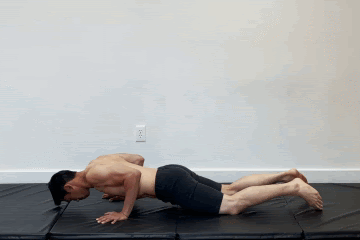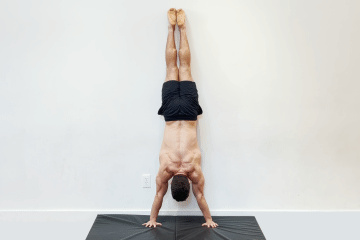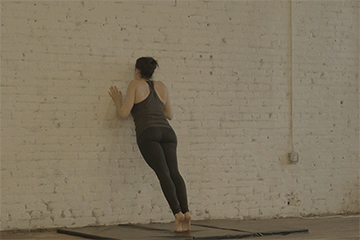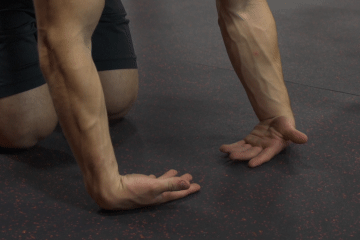
Join the tribe of Movement & Calisthenics Athlete – People just like you that are working with their own body weight to get strength, lose fat build muscle, recover from injuries and live their best lives!
Sometimes, you’ve just got to ask yourself, “Am I really doing push-ups?”
Push-ups are a popular exercise choice that many people do in order to get a stronger chest and arms. Unfortunately, many people make common mistakes when doing them which can lead to no progress at all or worse, it can result in injuries, aches, and pain.
Push-ups are one of the most common exercises in any fitness routine, whether it be calisthenics or your traditional gym routines.
They can be done anywhere, anytime on just about any surface. Push-ups are also one of the best ways to work your upper body and core muscles – but they’re not without their common mistakes!
In this article, you’ll learn 10 common push-up mistakes that could be sabotaging your progress…
What is a push-up?
Let’s first brush up on the exercise and why it’s one of the best exercises. Push-up is a crucial pushing exercise that hits the upper body, particularly the chest, triceps, and shoulder region.
It’s basically a bodyweight bench press. In fact, a 2019 study shows that the push-up movement can lead to similar gains compared to the weightlifting counterpart. Of course, this is only effective if you’re avoiding the push-up mistakes with poor form.
Push-ups are a fundamental calisthenics movement that should be implemented in upper body strength training, hypertrophy goals, and muscular endurance work.
There are many variations of performing push-ups that can shift the focus of the exercise. You can get more emphasis on the chest, triceps, or shoulders. You can even modify it to train for specific movement patterns such as training for planche.
For now, we’re going to talk about the classic, normal push-ups on the floor targeting the correct muscles and avoiding these push-up mistakes below.
Why does proper form matter?
You might be wondering why we emphasize our attention to avoiding poor form and technique.
Here’s why:
- Faster progress
- Correctly targeting muscles
- Unnecessary loading on untargeted joints and muscles
- Building good habits that transfer to other calisthenics movements
- Proper muscle activation
We only achieve these things above if we are doing the correct technique and form.
But there’s a caveat: form breakdown is normal and acceptable especially when you’re nearing your muscular failure.
The perfect form may not always be attainable when fatigue (usually in the later reps and sets) sets in but the challenge is to maintain your body posture and technique and minimize form breakdown.
Push to target the muscles and get that extra reps into your latter sets and reps with a very slight deviation with the pushup form.
10 PUSH UP MISTAKES
❌Incomplete range of motion
The common issue we encounter with people doing push-ups is doing a limited range of motion.
The full range of motion is from the starting position, all the way down when your chest almost touches the floor, then back to the starting position FOR ALL REPS.
Incomplete motion is usually a sign of a weak upper body or it could be the core strength.
Exception: Half-rep push-ups (stopping when your arms are bent at a 90-degree angle) is an acceptable progression when learning the push-ups. Aim to go deeper when you build enough pushing strength.
But the exception is only allowed if you’re still doing the proper technique and form in other areas, and not getting only a 10% range of motion. If that’s the case, scale down the exercise.
❌Arching lower back
Arching your back is good for mobilization during the cat camel exercise but not good when doing the push-ups.
When the rib cage sinks with your hips, your core is probably not yet strong enough to hold the position. Your lower back arches to compensate since the core cannot maintain the straight line. Doing push-ups with an arching lower back can lead to lower pains which are very unnecessary and troublesome over time.
However, the arch can also be just a lack of awareness on how to position your hips and not having enough tension on your core.
Make sure you tilt your hips backward (posterior pelvic tilt) to engage the core and avoid arching the lower back.
Practice the plank position to achieve a stable hold and address weakness in core strength. Keep your body always in a straight line.
❌Holding your breath
Even if you’re doing the proper form, you might be holding your progress by holding your breath.
Not breathing properly robs you of more potential gains since you make the exercise easier and your hold more stable.
As a guideline, breath in when going down, breath out as you push, and go up back to the starting position.
❌Flaring elbows
Keep your elbows within the scapular plane and not pushing towards the 0 – degree. Photo from Rdella training.
Another common mistake that lies either from lack of awareness of weakness in specific pushing muscles is flaring your elbows outside the scapular plane.
Keep the elbow position tucked close to the serratus anterior.
Flaring elbows work double-time and put unnecessary loading on your shoulders which could result in shoulder pain or elbow pain.
❌Incorrect head position
Don’t let your head drop down. Keep it neutral.
Film yourself doing a push-up. Is your head protruding away from your body?
Avoid that mistake and keep the head position neutral.
The cervical spine plays an important role in holding this position. Lack of awareness or poor cervical spine mobility keeps proper spine alignment in the neutral position for the neck muscles.
Another one is making a double chin which is inherently wrong and causes too much tension on your neck.
❌Wrong scapula position
Learn how to retract the scapula while keeping your shoulders depressed.
Like in many other calisthenics exercises and movements, the shoulder blades require much-needed stability in order to execute a proper push-up.
Depress your shoulders at all times by pushing it away from your ears.
Maintain a neutral position at the top then actively pull your shoulder blades together as you begin to descend. The shoulder blades remain retracted at the bottom then reverse the motion.
Exception: You can also protract your shoulders blades (pushing them away from each other) at the top if you’re specifically working on your planche or general scapula strength, but it’s not necessary for a regular push-up.
❌Excessive speed
Explosive push-ups and fast push-ups has its place but not if we’re working on our strength and muscle.
Going too fast on your reps opens up the risk of committing more push-ups mistakes. It’s also an unstable position for the shoulder joints which can lead to aching shoulders.
Perform push-ups with control in a controlled tempo.
Exception: For sport-specific push-ups, you can get away with these fast push-ups.
Explosive push-ups are usually done with an explosive concentric (upward) then just catching the eccentric (downward) with control.
❌Not progressive
Handstand push-ups for the more advanced athletes.
Doing as many reps as possible isn’t always going to cut it when doing the exercise. There are many other ways of increasing the difficulty of the exercise and making it progressive like:
- Modifying the tempo or the angle
- Decreasing rest periods
- Increasing overall training volume and training frequency
Another way is to use the harder progressions.
When full pushups are starting to get too easy, it’s time to develop strength by increasing the difficulty of the exercise.
Here are solid options for more experienced athletes to work with or work towards:
- Ring push-ups
- Weighted push-ups
- One-arm push-ups
- Planche push-ups
- Psuedo planche push-ups
- Shoulder push-ups
- Handstand push-ups
- Raised surface incline pushup
❌Wrong progression
Work with easier progression if you need to. Don’t force yourself too much.
Sometimes, our ego gets the better of us.
If you have bad form and technique with your push-up and can’t seem to make it work, maybe you’re just not strong enough at all.
Consider using an easier progression to manage full pushup with correct form but with an easier variation.
Get into the correct position, hit the correct muscles, and keep elbows and shoulders safe.
Below are a few options you can choose scaling back:
- Wall push-ups
- Incline push-ups – This one is easily scaled depending on the height of elevation
- Knee pushups
To address certain weaknesses in your form, you can also adjust the variables such as:
- Adding pauses or holds at sticking points
- Using negatives or eccentrics
- Using a half-rep
You will gain much better progress with dialing the intensity back rather than grinding the standard pushup but doing it in the wrong way!
❌Enduring pain
If you’re feeling pain in your wrists, maybe your wrists cannot handle the flexion and pressure yet.
The old adage, “no pain no gain,” doesn’t provide a smart perspective in the fitness journey.
When you experience pain performing pushups, you need to stop and address your situation.
Usually, pain comes from wrists joints, shoulders, or chest muscles.
The pain is a sign of potential weakness, or dysfunction, meaning something is wrong and not working properly.
DON’T PUSH THROUGH THE PAIN as it will probably get worse if you do so.
Enduring pain in a very unstable position can worsen your state and can ultimately lead to injury.
It’s probably better to check with your local physiotherapist if you do feel pain when doing the exercise. Maybe you can opt for some alternative that’s more wrist or shoulder-friendly depending on your situation.
How to do a proper push-up
Do proper push-up form in a full range of motion, maintain a solid body position, and good technique.
Keep it simple.
- Hands shoulder-width apart aligned with your shoulders. Feet extended and together.
- Straighten your body with a posterior pelvic tilt.
- Add tension for the entire body and check proper spinal alignment along with the neutral scapula position.
- Lower down with control until your chest is near the ground with your elbows tucked close to your body.
- Push back up to the stable and locked position at the top.
- Repeat for gains!
TAKE NOTE: You can adjust hand position just outside shoulder width depending on your personal preference.
Recap
Here’s a quick recap of the common push-up mistakes that you should always be avoiding:
- Incomplete range of motion
- Arching the lower back with lack of core tension
- Holding your breath during reps
- Flaring your elbows outwards the scapular plane
- Incorrect head position that’s too low or too high
- Shrugged shoulders and lack of scapula retraction
- Too fast without control
- Not progressive with the push-ups
- Using a too easy progression
- Enduring pain when working with the motions
The push-up is a fantastic exercise everybody should master. These mistakes are easy to avoid if you put your mind to it and take the process step-by-step rather than rushing while your body isn’t ready for the movement.
Remember, doing these mistakes isn’t only slowing your progress but can also sabotage your progress by resulting in injuries and pain.
If you need more help with calisthenics fundamentals, begin your personalized calisthenics journey so you can get faster progress in a safer and efficient manner.
Fitness is not a race. It’s a life-long process.
Train the smart way by understanding where you are in your fitness journey and what your body is capable of.
TAKE THE ASSESSMENT NOW!












